
The kitchen is often the heart of the home and one of the most expensive purchases. In the event of damage, it’s crucial to know whether the kitchen is covered by household contents insurance or building insurance. This article explores the differences and clarifies common misconceptions, especially regarding fitted kitchens, kitchen units, and modular kitchens.
The Fitted Kitchen: Building Component or Household Contents?
The classic definition of household contents states that anything that would fall out if you turned the house upside down belongs to household contents insurance. However, there is an exception: the fitted kitchen. Although it is not anchored to the floor, it is considered part of the building and thus covered by building insurance. The reason lies in the construction of a fitted kitchen: custom-made and handcrafted, making separation without significant loss of value impossible.
Kitchen Units and Modular Kitchens: Part of Household Contents
Modern kitchens usually consist of prefabricated parts that can be easily removed and reassembled in another building. These series-fitted kitchens or kitchen units are covered by household contents insurance. A court ruling by the District Court of Düren in 2003 confirmed that a series-produced fitted kitchen is not a building component and is therefore not covered by building insurance. Instead, it is part of household contents.
What Happens in the Event of Damage?
The kitchen is covered by the usual insured risks such as fire, water damage, or overvoltage, regardless of whether it belongs to household contents or building insurance. For permanently installed fitted kitchens, a gap may arise if certain electrical appliances, such as the stove or dishwasher, are not included in the building insurance. In such cases, they should be covered by household contents insurance.
The Kitchen in Rental Properties
If the kitchen belongs to the landlord, it’s important to determine the type of kitchen. A fitted kitchen falls under the landlord’s building insurance, while a modular kitchen is covered by the tenant’s household contents insurance. In the event of damage, tenants should check their private liability insurance to see if it covers rental property damages. If it does, damages caused by the tenant, such as a broken countertop, would be covered.
How to Protect Your Kitchen
To be on the safe side, when taking out household contents insurance, ensure that the value of the kitchen is included in the insurance sum. This is usually sufficient with the typical 650 euros insurance sum per square meter. Additionally, a separate glass insurance policy can be useful to cover damages such as a broken ceramic hob.
Additional Security
To ensure your kitchen is included in household contents insurance, you can explicitly note this in the insurance policy. Tenants should also coordinate with their landlord about who bears the costs in the event of damage to avoid future misunderstandings.
By considering these aspects, you can ensure your kitchen is well insured in the event of damage.





